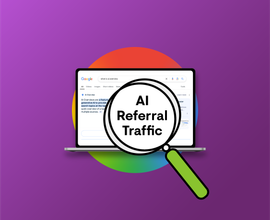An In-Depth Look at Google’s AI Overviews (formerly Search Generative Experience)
Google changed the entire search landscape once before, and they’re doing it again, this time with the help of AI. Google’s AI Overviews or AIO (formerly SGE—Search Generative Experience) is a whole new ballgame for the way we search and find information online.
With the goal of providing users with quick answers to complex questions, AIO uses generative AI to break down the top SERP content into a single snippet at the top of the page. The implications of AIO are huge for your site’s organic discoverability and the future of search as we know it.
We’re in the midst of a revolution in search, and it’s powered by generative AI. One of the main drivers of the changing search landscape is Google itself, which has rolled out its chatbot, Google Bard , and is experimenting with AI-powered search in the form of its search generative experience. While impactful in their own right, chatbots pale in comparison to the potential effects of SGE .
In no uncertain terms, SGE will fundamentally change the way that users get their questions answered and how sites are found on search engines. How will you respond to the future of search? Well, chance favors the well-prepared, so let’s dive in.
On May 14, 2024, Google announced the roll out of AI Overviews (formerly part of Search Generative Experience, or SGE) in the U.S. Check out our most recent blog article for six strategies to help navigate this new development given what we know so far, covering E-E-A-T, content and ranking shifts, and more.
What is AIO?
AIO (formerly SGE) is an experimental update to Google’s search engine that uses artificial intelligence to generate contextual answers to complex questions. It leverages AI in the following three ways to enhance its search experience.
- AI snapshot: The AI-generated snippet located at the top of the Google SERP that answers the users' questions. See our screenshot of the AI snapshot answering the query ‘What is the strongest bone in the human body?’ below.
- Conversational mode: Answers follow-up questions related to a topic while keeping the context of the original search.
- Vertical experiences: Provides a preferred list of features and more product details in commercial searches.

In short, Google’s AI will quickly comb the SERP, find the answer to a user’s question, and quickly create a digestible answer at the top of the SERP in a new snippet called the AI spotlight. From there, users can ask follow-up questions and interact with the AI rather than follow organic or paid links below.
What are AI overviews?
AI Overviews is Google’s updated version of AI-powered search, formerly known as it’s Search Generative Experience (SGE) Now, why did Google change the name upon its official release? Because the experience itself is quite different from what SGE provided in the testing environment.
What are the differences between AI Overviews and SGE?
On the surface, not much is different between the technologies. Both provide AI-generated responses to some queries in order to give users quicker—if not always as accurate—answers to their questions. AI Overviews still does this and is now fully available within Google Search in the US and Canada. Users no longer have to opt into AI Overviews within Google Labs. It’s theoretically available for any Google search.
The key differences we’re seeing so far are in the number of queries for which AI Overviews appear and how much of the SERP the overview takes up. For starters, AI-generated responses seem to be appearing less frequently than generated responses did in SGE. For instance, several of the queries we used as examples to illustrate the power of SGE no longer have AI-generated responses. They just have the same old Google SERP.

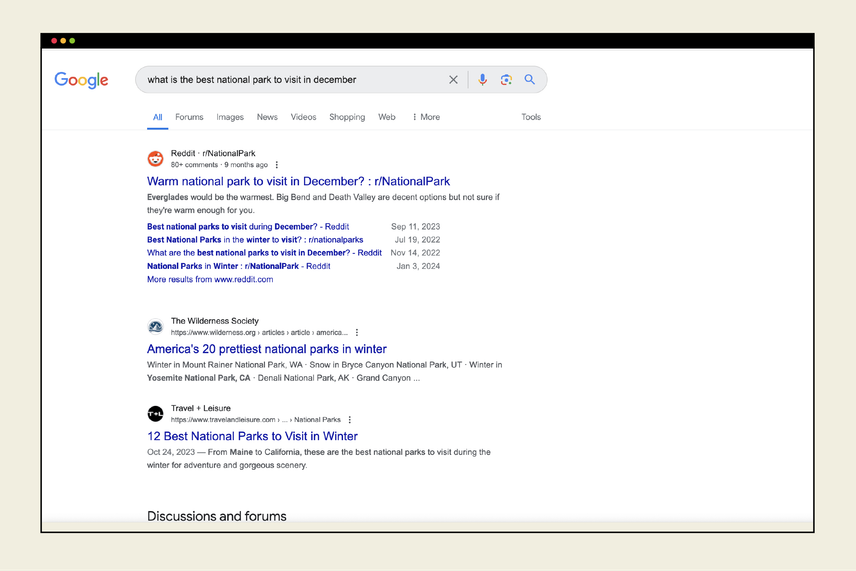
As you can see, the SERP looks completely different, with Google pushing users towards organic links, including Reddit, to answer this query rather than an AI-generated response.
Another thing you may have noticed from those screenshots is that the AI overview doesn’t dominate the SERP in the same way that SGE’s AI Snapshot did. Users can still narrow results with the left hand sidebar, and the fold of the AI overview is a bit higher up the page than it had been previously. In addition, the content of the AI Overview itself is different, despite pulling from the same source.
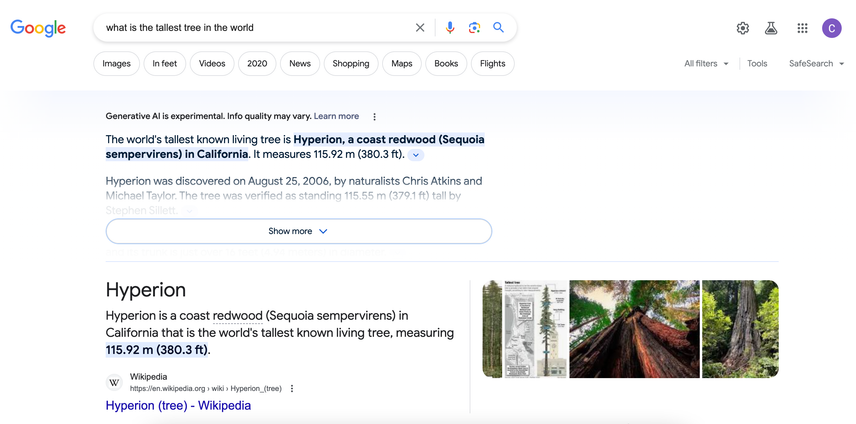
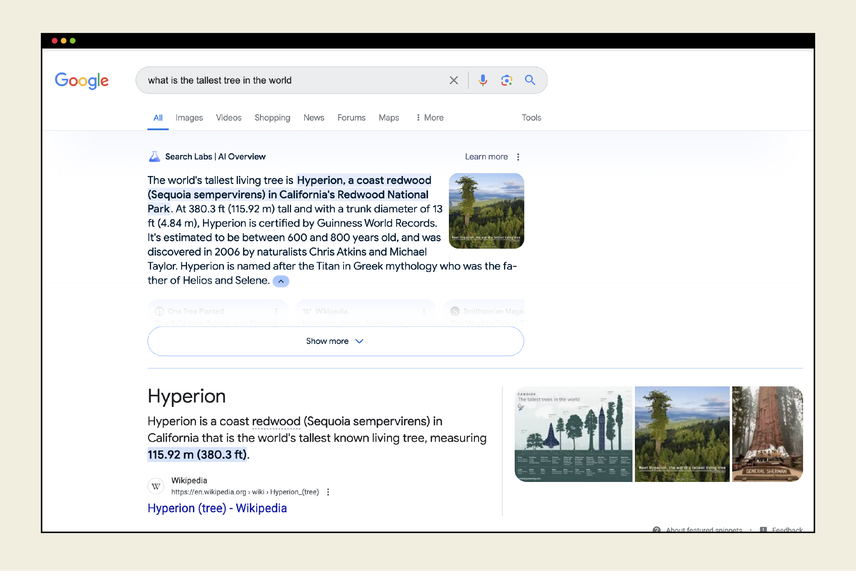
Now compare those SERPs, to this one for the query: 'security lights.' This query gives you an entirely different looking SERP. While still offering the AI Overview, the page is full of different kinds of results including products, as well as ways to refine your search further.

All this is to say that AI Overviews can still have a significant impact on your organic traffic for certain queries, but maybe not to the same extent just yet. It’s important to remember that just because some queries aren’t getting the AI Overview treatment doesn’t mean they won’t as Google continues to tinker with the technology, so as always, keep an eye on your most important keywords for any sudden shifts.
Why is AIO important?
We believe that this is the single biggest change to the search landscape since Google itself. Google’s SGE will quickly provide users with the answers they need and not necessarily direct users to other sites or content. As you can see, this is going to have a huge impact on your business. Specifically, SGE will affect your site in two significant ways, from an organic discoverability perspective and a productivity perspective.
What is the impact of AIO on the SERP?
Based on the last few paragraphs, the implications here should be fairly obvious, but let’s break it down. First, consider the layout of the SERP page with the AI spotlight. The AI snippet takes up the best SERP real estate there is, pushing down the paid and organic results and even the featured snippetsFeatured Snippets
Featured snippets are highlighted excerpts of text that appear at the top of a Google search results page in what is known as ‘Position 0’.
Learn more, and that’s before we expanded the AI-generated snippet. As you can expect, once you expand the AI spotlight section, it dominates the page, and every other result is pushed below the fold.
The impact on site traffic and the CTR of organic results will be devastating even if your rankingsRankings
Rankings in SEO refers to a website’s position in the search engine results page.
Learn more remain the same. And in case you thought your paid ads would be safe, we have bad news for you. The AI spotlight will take precedence over every result, whether organic, paid, or featured.
While Google’s goal remains to get its users the answers they need, SGE marks a shift in how it gets users from point A to point B. Specifically, Google used to give users answers to their questions by directing them toward helpful sites and content, ultimately taking them away from the Google SERP. With SGE, Google is encouraging users to remain on the SERP.
It’s important to remember that the AI-generated snippet is composed of information taken from high-ranking, valuable, and relevant content that appears on the SERP for a given keywordKeyword
A keyword is what users write into a search engine when they want to find something specific.
Learn more, and SGE will cite those sources in the snippet, so users can navigate to the site if they choose. However, given that users get answers to their specific questions so quickly and can use SGE to ask follow-up questions, searchers will have fewer reasons than ever to actually click on blue links on SERPs.
That said, while SGE is changing the nature of the SERP, Google does have an important reason not to completely redo it and remove links to sources, and that reason is Google Ads. Google makes a lot of money through Ad revenue, so they have a vested monetary interest in serving ads that appear like organic links on the SERP. So while this is changing search, some things will still look familiar.
Another consideration is productivity. Google’s continued moves towards AI are in line with much of the search industry at the moment, and many companies are already leveraging AI to improve their processes and productivity. Those companies with experience using AI will have a head start on those that are slower to adapt.
How does AIO work?
SGE, still part of Google Labs , is an early step in transforming the search experience with generative AI . But what does that mean in practice? It means that in certain instances when users have a specific question, Google’s AI will review the top-ranking SERP content on that topic and generate a specific answer to that question without the user having to click a link or visit a site.
So, if you have a specific question like: “What is the tallest tree in the world?” your Google SERP will look like this.

And that’s before you click ‘show more,’ which expands the AI snapshot even farther down the page and establishes SGE’s conversational mode, which allows users to ask follow-up questions. No matter how many follow-ups are asked, SGE will keep the context of the preceding queries.
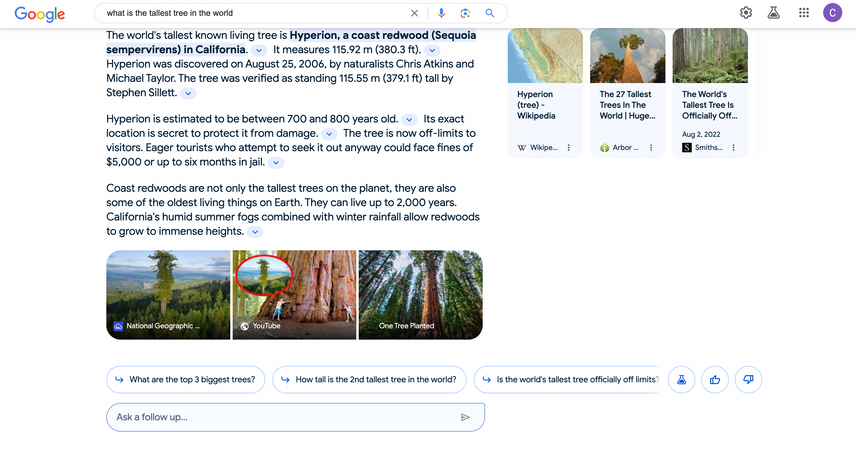
Think about the last time you Googled something. You most likely had a specific question and didn’t want to read a full article about a blue whale to get your answer. Your users are the same way. They’re more likely to have questions like: “When is the best time of year to visit Florida?” SGE allows them to search for that specific question and get an AI-generated answer in seconds. In fact, generally, Google's AI generates its snapshot in less than 7 seconds .

Unfortunately, there’s not exactly a hard and fast rule on which queries the AI snapshot will appear for. In Google’s own words, the snapshot will appear “when appropriate… to help people quickly get an overview on a topic, with factors to consider and helpful information.”
While the “when appropriate phrasing is vague, it’s clear that Google wants to make sure its AI is passing along true and valuable information to its users. But given AI’s well-documented limitations, like providing incorrect or misleading information, providing safe information is also a priority for Google . For example, Google may not want AI to answer if a user asks if they should see a doctor for certain health symptoms or if a financial investment is worth it. For YMYL questions, Google is still going to be cautious and steer users to correct information rather than fast information.
In short, Google is holding SGE to “an even higher standard when it comes to generating responses about certain queries where information quality is critically important.”
So we know that SGE may not appear for certain queries, but for more innocuous searches, when will Google deem it “appropriate” to provide AI-powered responses? To figure out a little about when the AI snapshot will appear based on trial and error.
For example, we’ve found that while the option to generate an AI snapshot appears on most of our searches—once SGE is activated—the snapshot tends to automatically populate when we ask a direct question to Google. For instance, we searched for “Acadia National Park,” and Google didn’t automatically populate the AI snapshot. It was unsure what we needed help with, so Google will give the option to generate an AI response, but the layout of the SERP looks much more familiar.
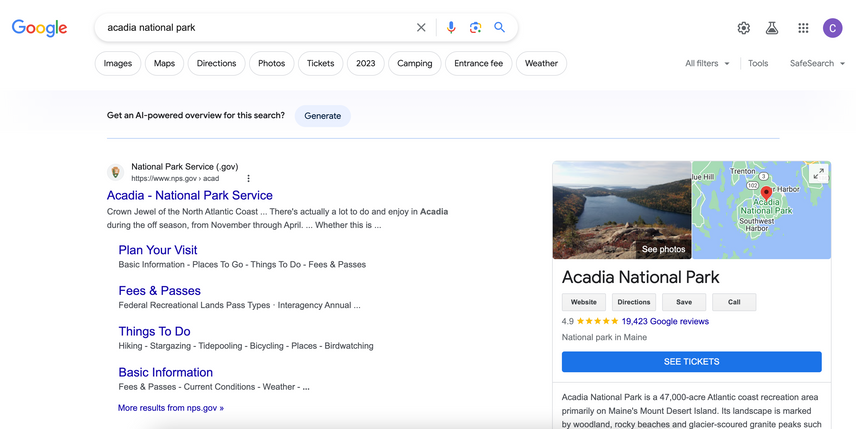
But when we searched a more specific question around national parks, like: what is the best national park to visit in December? That gave SGE a more specific context to work within and allowed it to quickly process an AI-generated response.
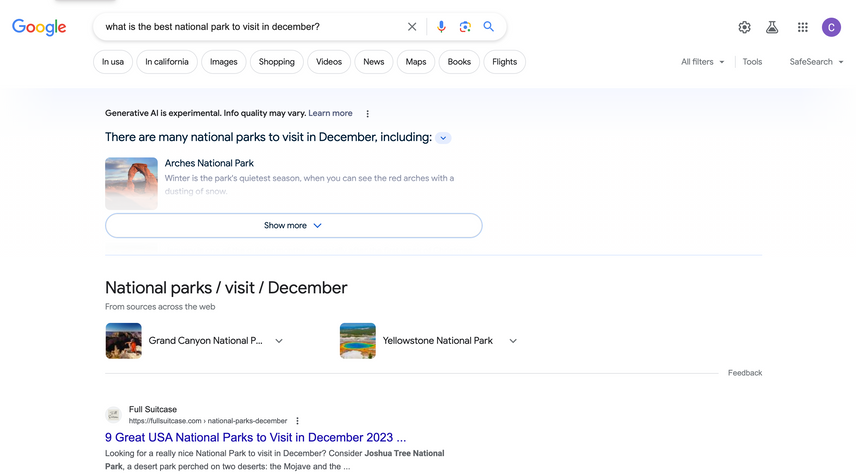
Limitations of AIO
Much like AI chatbots, generative AI output is far from perfect and requires a thorough approach to get the most out of it. Like ChatGPT and other tools, SGE will be prone to hallucinations that cause it to provide incorrect or misinterpreted information, as well as internal biases that can skew its output.
While SGE will usher in a new, more efficient way of finding answers to questions, the inclusion of AI means that it’s critical to thoroughly review each output for clarity, consistency, and accuracy.
How do I get included in the AI Overview?
SGE will significantly harm the organic discoverability of every search resultSearch Result
Search results refer to the list created by search engines in response to a query.
Learn more that isn’t included in the AI snapshot—and even some within the snapshot—because users will have less of a reason to follow a link to actual content. So your best chance to keep your traffic, impressions, and CTR strong is to appear within that AI snapshot. But how do you do that?
From what we can tell, SGE will pull the most relevant and helpful snippet of the content appearing in the top 2 organic results for its answers . So the best thing you can do is take the time before SGE is fully rolled out to prepare your site and optimize your content for an AI-powered world. Another thing to consider is schema markup, which can help set your content apart from others and help your content get pulled into SGE.
While there’s still no definitive answer to appearing in the AI snapshot, it pays to check out our in-depth SGE resources and download our AI-readiness checklist to make sure you’re prepared for the future of search. In addition, Conductor’s comprehensive suite of content and technical SEO features help you optimize your content and properly prepare for SGE.
How does optimizing for AIO differ from traditional optimization?
One area where SGE optimizations distinguish themselves from traditional optimization efforts is in detailed schema. Schema provides context and makes it easier for search algorithms to understand your content, which should have a huge impact on SGE. The faster that an AI can break down and understand your site, the faster it can find information to provide in its AI snapshot. While schema is important for content optimizations, we expect them to only grow in importance as SGE is more widely used.
In addition to schema, SGE optimization will have many of the same considerations as content optimization, such as technical SEO and performance metrics like page speed. If your site is slow, often crashes, or is difficult to use, it makes for a poor user experienceUser Experience
User experience (or UX for short) is a term used to describe the experience a user has with a product.
Learn more which factors into search algorithms.
FAQs
How do I enable AIO?
Google users based within the United States can enable SGE on Google Chrome using their personal Google account. All you need to do is:
- Open a new Google tab.
- Click the Search Labs icon.
- Find the SGE card and turn on the experiment.
- Try out an example.
SGE will not work if you’re working in an incognito tab.
Is AIO safe to use?
Yes, it’s safe. That said, like any AI, SGE has inherent flaws. For example, it can sometimes provide incorrect information, misinterpret requests, or give biased answers to questions, so you’ll need to be careful and thoroughly research a topic before taking SGE’s word.
In addition, there are privacy and security concerns with generative AI and SGE. Google already tracks your personal search data across platforms and Large Langauge Models that power generative AI tools are trained on user data. So when a user interacts with SGE, it will add that information to its knowledge base and may record the questions and prompts a user input. Plus, SGE cannot be used in incognito mode.
Overall, SGE is safe but beware of inputting any sensitive or personal information.
How is AIO different from Google Bard?
Both Google Bard and SGE are powered by generative AI, but each tool serves a different purpose. Firstly, Google Bard is not integrated into traditional Google search. It’s strictly a chatbot, like ChatGPT. However, Bard can reference the entirety of Google’s up-to-date index to create answers, whereas ChatGPT’s knowledge base has no data post-2021.
On the other hand, SGE adds AI power to a traditional Google search, incorporating AI-generated answers into the SERP to provide more efficient answers to users.
Summarizing AIO
To sum everything up, Google’s search generative experience is a massive shift for search. By incorporating AI-generated responses in the SERP, Google is promoting a faster and more efficient search experience for its users. That said, it comes at the expense of sites and content that previously drove significant organic traffic at the top of SERPs. Companies are going to have to find a way to optimize their content for the AI-powered SGE or risk a devastating effect on their traffic. Welcome, everyone, to a new era of search.


